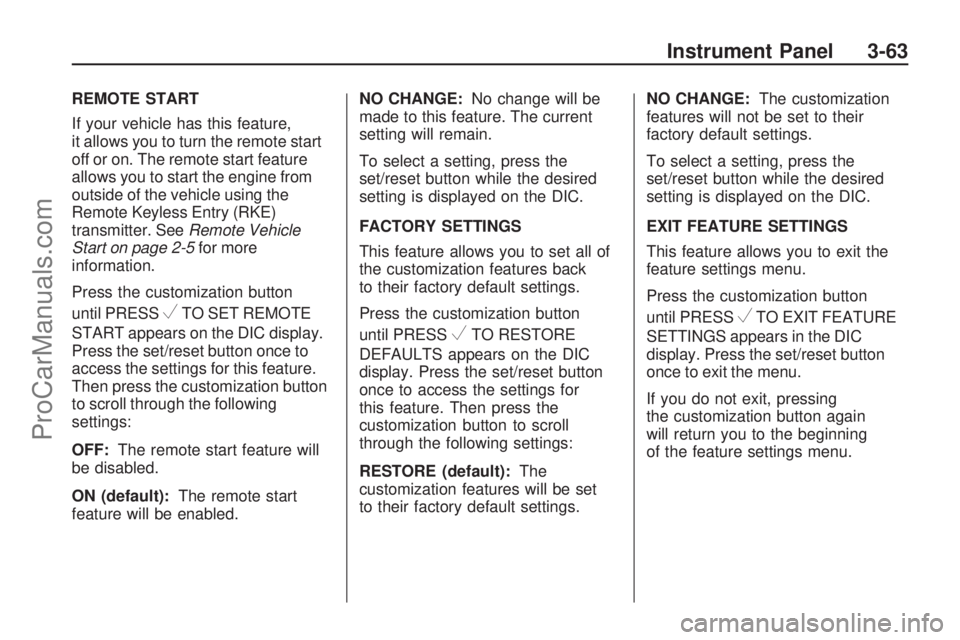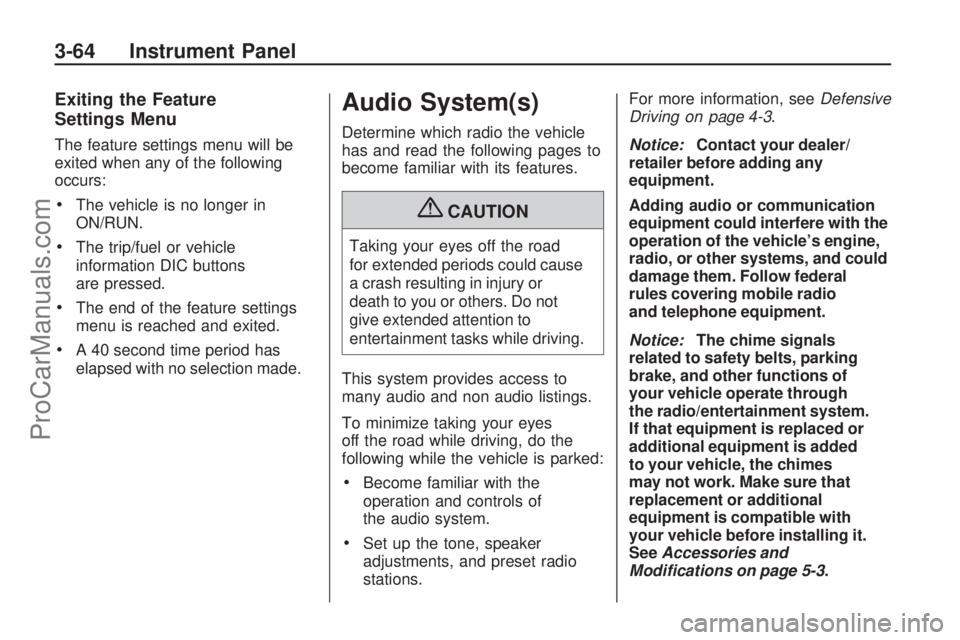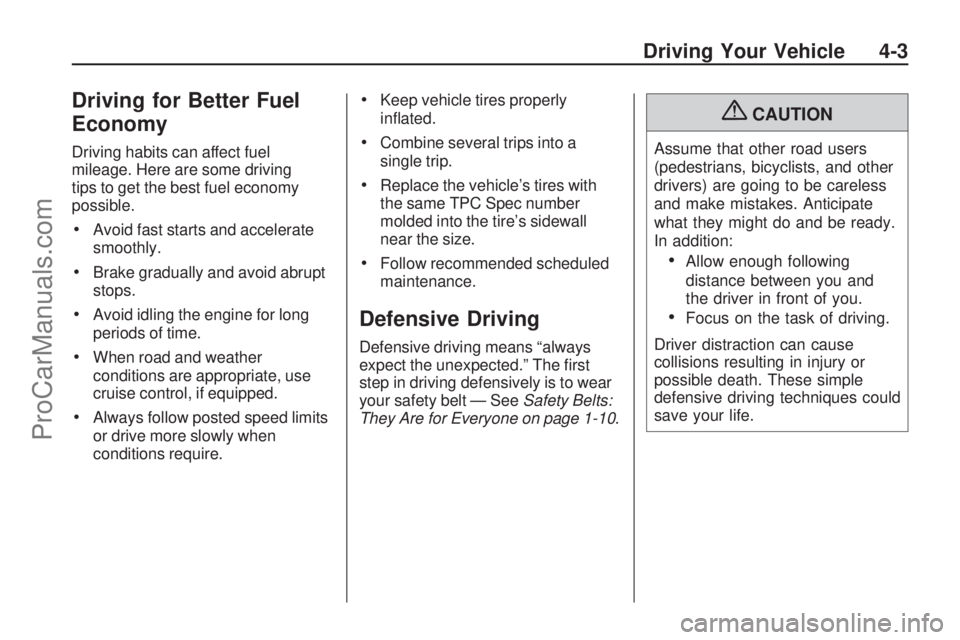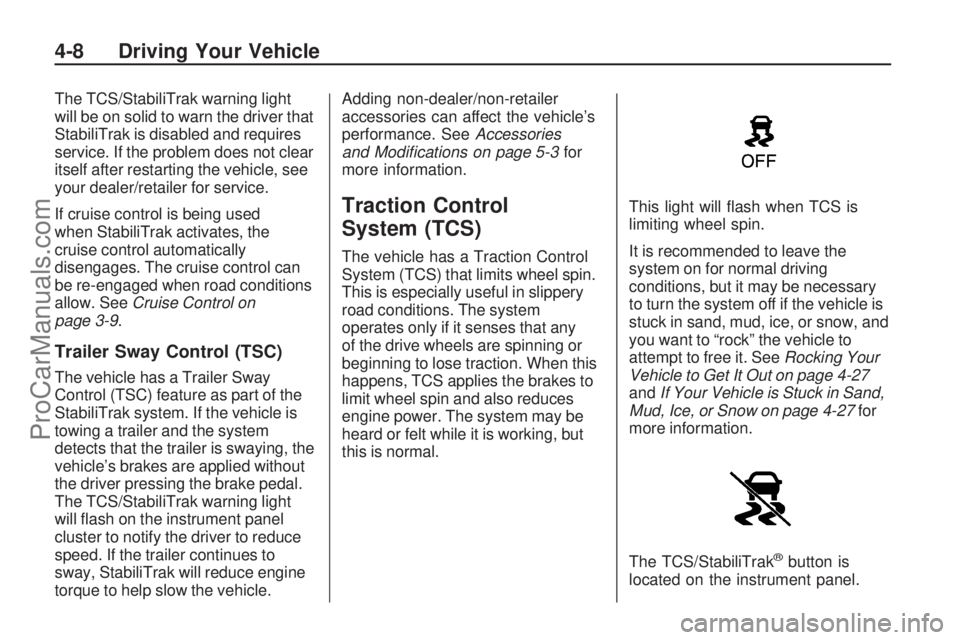engine SATURN VUE 2009 Workshop Manual
[x] Cancel search | Manufacturer: SATURN, Model Year: 2009, Model line: VUE, Model: SATURN VUE 2009Pages: 386, PDF Size: 2.3 MB
Page 166 of 386

TIRE LEARNING ACTIVE
On vehicles with the Tire Pressure
Monitor System (TPMS), this
message displays when the TPMS
is re-learning the tire positions on
your vehicle. The tire positions must
be re-learned after rotating the tires
or after replacing a tire or sensor.
SeeTire Inspection and Rotation
on page 5-56,Tire Pressure
Monitor System on page 5-51,
andInflation - Tire Pressure on
page 5-49for more information.
TRACTION CONTROL OFF
This message displays when
the Traction Control System (TCS)
turns off. SeeStabiliTrak
®System
on page 4-7for more information.This message only displays
while the ignition is in ON/RUN
and disappears after 10 seconds,
unless it is acknowledged or an
urgent warning appears.
Any of the following conditions may
cause the TCS to turn off:
The TCS is turned off by pressing
the TCS/StabiliTrak button.
SeeStabiliTrak
®System on
page 4-7for more information.
The battery is low.
There is a TCS failure. See your
dealer/retailer for service.
TRACTION CONTROL ON
This message displays when the
Traction Control System (TCS) turns
on. SeeStabiliTrak
®System on
page 4-7for more information.
TRANSMISSION HOT IDLE
ENGINE
Notice:If you drive your vehicle
while the transmission �uid is
overheating and the transmission
temperature warning is displayed
on the instrument panel cluster
and/or DIC, you can damage the
transmission. This could lead to
costly repairs that would not be
covered by your warranty. Do not
drive your vehicle with overheated
transmission �uid or while the
transmission temperature warning
is displayed.
This message displays along with a
chime if the transmission �uid in the
vehicle gets hot. Driving with the
transmission �uid temperature high
can cause damage to the vehicle.
Stop the vehicle and let it idle to
allow the transmission to cool.
This message clears and the chime
stops when the �uid temperature
reaches a safe level.
3-56 Instrument Panel
ProCarManuals.com
Page 173 of 386

REMOTE START
If your vehicle has this feature,
it allows you to turn the remote start
off or on. The remote start feature
allows you to start the engine from
outside of the vehicle using the
Remote Keyless Entry (RKE)
transmitter. SeeRemote Vehicle
Start on page 2-5for more
information.
Press the customization button
until PRESS
VTO SET REMOTE
START appears on the DIC display.
Press the set/reset button once to
access the settings for this feature.
Then press the customization button
to scroll through the following
settings:
OFF:The remote start feature will
be disabled.
ON (default):The remote start
feature will be enabled.NO CHANGE:No change will be
made to this feature. The current
setting will remain.
To select a setting, press the
set/reset button while the desired
setting is displayed on the DIC.
FACTORY SETTINGS
This feature allows you to set all of
the customization features back
to their factory default settings.
Press the customization button
until PRESS
VTO RESTORE
DEFAULTS appears on the DIC
display. Press the set/reset button
once to access the settings for
this feature. Then press the
customization button to scroll
through the following settings:
RESTORE (default):The
customization features will be set
to their factory default settings.NO CHANGE:The customization
features will not be set to their
factory default settings.
To select a setting, press the
set/reset button while the desired
setting is displayed on the DIC.
EXIT FEATURE SETTINGS
This feature allows you to exit the
feature settings menu.
Press the customization button
until PRESSVTO EXIT FEATURE
SETTINGS appears in the DIC
display. Press the set/reset button
once to exit the menu.
If you do not exit, pressing
the customization button again
will return you to the beginning
of the feature settings menu.
Instrument Panel 3-63
ProCarManuals.com
Page 174 of 386

Exiting the Feature
Settings Menu
The feature settings menu will be
exited when any of the following
occurs:
The vehicle is no longer in
ON/RUN.
The trip/fuel or vehicle
information DIC buttons
are pressed.
The end of the feature settings
menu is reached and exited.
A 40 second time period has
elapsed with no selection made.
Audio System(s)
Determine which radio the vehicle
has and read the following pages to
become familiar with its features.
{CAUTION
Taking your eyes off the road
for extended periods could cause
a crash resulting in injury or
death to you or others. Do not
give extended attention to
entertainment tasks while driving.
This system provides access to
many audio and non audio listings.
To minimize taking your eyes
off the road while driving, do the
following while the vehicle is parked:
Become familiar with the
operation and controls of
the audio system.
Set up the tone, speaker
adjustments, and preset radio
stations.For more information, seeDefensive
Driving on page 4-3.
Notice:Contact your dealer/
retailer before adding any
equipment.
Adding audio or communication
equipment could interfere with the
operation of the vehicle’s engine,
radio, or other systems, and could
damage them. Follow federal
rules covering mobile radio
and telephone equipment.
Notice:The chime signals
related to safety belts, parking
brake, and other functions of
your vehicle operate through
the radio/entertainment system.
If that equipment is replaced or
additional equipment is added
to your vehicle, the chimes
may not work. Make sure that
replacement or additional
equipment is compatible with
your vehicle before installing it.
SeeAccessories and
Modifications on page 5-3.
3-64 Instrument Panel
ProCarManuals.com
Page 207 of 386

Driving for Better Fuel
Economy
Driving habits can affect fuel
mileage. Here are some driving
tips to get the best fuel economy
possible.
Avoid fast starts and accelerate
smoothly.
Brake gradually and avoid abrupt
stops.
Avoid idling the engine for long
periods of time.
When road and weather
conditions are appropriate, use
cruise control, if equipped.
Always follow posted speed limits
or drive more slowly when
conditions require.
Keep vehicle tires properly
in�ated.
Combine several trips into a
single trip.
Replace the vehicle’s tires with
the same TPC Spec number
molded into the tire’s sidewall
near the size.
Follow recommended scheduled
maintenance.
Defensive Driving
Defensive driving means “always
expect the unexpected.” The �rst
step in driving defensively is to wear
your safety belt — SeeSafety Belts:
They Are for Everyone on page 1-10.
{CAUTION
Assume that other road users
(pedestrians, bicyclists, and other
drivers) are going to be careless
and make mistakes. Anticipate
what they might do and be ready.
In addition:
Allow enough following
distance between you and
the driver in front of you.
Focus on the task of driving.
Driver distraction can cause
collisions resulting in injury or
possible death. These simple
defensive driving techniques could
save your life.
Driving Your Vehicle 4-3
ProCarManuals.com
Page 209 of 386

Braking
SeeBrake System Warning Light on
page 3-31.
Braking action involves perception
time and reaction time. Deciding
to push the brake pedal is
perception time. Actually doing
it is reaction time.
Average reaction time is about
three-fourths of a second. But that
is only an average. It might be
less with one driver and as long as
two or three seconds or more with
another. Age, physical condition,
alertness, coordination, and eyesight
all play a part. So do alcohol, drugs,
and frustration. But even in
three-fourths of a second, a vehicle
moving at 60 mph (100 km/h) travels
66 feet (20 m). That could be a lot
of distance in an emergency, so
keeping enough space between the
vehicle and others is important.And, of course, actual stopping
distances vary greatly with the
surface of the road, whether it is
pavement or gravel; the condition of
the road, whether it is wet, dry, or icy;
tire tread; the condition of the brakes;
the weight of the vehicle; and the
amount of brake force applied.
Avoid needless heavy braking. Some
people drive in spurts — heavy
acceleration followed by heavy
braking — rather than keeping pace
with traffic. This is a mistake. The
brakes might not have time to cool
between hard stops. The brakes will
wear out much faster with a lot of
heavy braking. Keeping pace with
the traffic and allowing realistic
following distances eliminates a lot of
unnecessary braking. That means
better braking and longer brake life.If the engine ever stops while
the vehicle is being driven, brake
normally but do not pump the brakes.
If the brakes are pumped, the pedal
could get harder to push down. If the
engine stops, there will still be some
power brake assist but it will be used
when the brake is applied. Once the
power assist is used up, it can take
longer to stop and the brake pedal
will be harder to push.
Adding non-dealer/non-retailer
accessories can affect vehicle
performance. SeeAccessories and
Modifications on page 5-3.
Driving Your Vehicle 4-5
ProCarManuals.com
Page 210 of 386

Antilock Brake
System (ABS)
This vehicle has the Antilock
Brake System (ABS), an advanced
electronic braking system that
helps prevent a braking skid.
When the engine is started and the
vehicle begins to drive away, ABS
checks itself. A momentary motor or
clicking noise might be heard while
this test is going on, and it might
even be noticed that the brake pedal
moves a little. This is normal.
If there is a problem with ABS,
this warning light stays on.
SeeAntilock Brake System (ABS)
Warning Light on page 3-32.Let us say the road is wet and you
are driving safely. Suddenly, an
animal jumps out in front of you.
You slam on the brakes and continue
braking. Here is what happens
with ABS:
A computer senses that the wheels
are slowing down. If one of the
wheels is about to stop rolling, the
computer will separately work
the brakes at each wheel.
ABS can change the brake pressure
to each wheel, as required, faster
than any driver could. This can
help the driver steer around
the obstacle while braking hard.
As the brakes are applied, the
computer keeps receiving updates
on wheel speed and controls braking
pressure accordingly.Remember: ABS does not change
the time needed to get a foot up to
the brake pedal or always decrease
stopping distance. If you get too
close to the vehicle in front of you,
there will not be enough time to apply
the brakes if that vehicle suddenly
slows or stops. Always leave enough
room up ahead to stop, even
with ABS.
Using ABS
Do not pump the brakes. Just hold
the brake pedal down �rmly and
let antilock work. The antilock
pump or motor operating might be
heard and the brake pedal might be
felt to pulsate, but this is normal.
Braking in Emergencies
ABS allows the driver to steer and
brake at the same time. In many
emergencies, steering can help more
than even the very best braking.
4-6 Driving Your Vehicle
ProCarManuals.com
Page 212 of 386

The TCS/StabiliTrak warning light
will be on solid to warn the driver that
StabiliTrak is disabled and requires
service. If the problem does not clear
itself after restarting the vehicle, see
your dealer/retailer for service.
If cruise control is being used
when StabiliTrak activates, the
cruise control automatically
disengages. The cruise control can
be re-engaged when road conditions
allow. SeeCruise Control on
page 3-9.
Trailer Sway Control (TSC)
The vehicle has a Trailer Sway
Control (TSC) feature as part of the
StabiliTrak system. If the vehicle is
towing a trailer and the system
detects that the trailer is swaying, the
vehicle’s brakes are applied without
the driver pressing the brake pedal.
The TCS/StabiliTrak warning light
will �ash on the instrument panel
cluster to notify the driver to reduce
speed. If the trailer continues to
sway, StabiliTrak will reduce engine
torque to help slow the vehicle.Adding non-dealer/non-retailer
accessories can affect the vehicle’s
performance. SeeAccessories
and Modifications on page 5-3for
more information.
Traction Control
System (TCS)
The vehicle has a Traction Control
System (TCS) that limits wheel spin.
This is especially useful in slippery
road conditions. The system
operates only if it senses that any
of the drive wheels are spinning or
beginning to lose traction. When this
happens, TCS applies the brakes to
limit wheel spin and also reduces
engine power. The system may be
heard or felt while it is working, but
this is normal.This light will �ash when TCS is
limiting wheel spin.
It is recommended to leave the
system on for normal driving
conditions, but it may be necessary
to turn the system off if the vehicle is
stuck in sand, mud, ice, or snow, and
you want to “rock” the vehicle to
attempt to free it. SeeRocking Your
Vehicle to Get It Out on page 4-27
andIf Your Vehicle is Stuck in Sand,
Mud, Ice, or Snow on page 4-27for
more information.
The TCS/StabiliTrak
®button is
located on the instrument panel.
4-8 Driving Your Vehicle
ProCarManuals.com
Page 213 of 386

Press and release this button to turn
off TCS. The TCS warning light will
be displayed on the instrument panel
cluster. The traction control system
can be turned back on by pressing
the TCS/StabiliTrak button.
If the system is limiting wheel spin
when the button is pressed, the
system will not turn off until there is
no longer a current need to limit
wheel spin. The system can
be turned back on at any time by
pressing the button again. If the TCS
light does not come on, TCS may
not be functioning properly and
the vehicle should be serviced at
your dealer/retailer.
Adding non-dealer/non-retailer
accessories can affect the vehicle’s
performance. SeeAccessories
and Modifications on page 5-3for
more information.All-Wheel Drive (AWD)
System
If the vehicle has all-wheel drive
(AWD), the AWD system operates
automatically without any action
required by the driver. If the front
drive wheels begin to slip, the rear
wheels will automatically begin to
drive the vehicle as required. There
may be a slight engagement noise
during hard use but this is normal.
This light is located on the
instrument panel cluster.
It will come on and stay on to
indicate there may be a problem
with the drive system and service is
required. If the light stays on, it must
be reset. To reset the light, turn the
ignition off and then back on again.
If the light stays on, see your
dealer/retailer for service.If the vehicle is exposed to extended
heavy AWD usage, the AWD system
will shut off to protect the system
from overheating. When the system
cools down, the AWD system will
activate again automatically; this
cool-down can take up to 20 minutes
depending on outside temperature
and vehicle use.
Steering
Electric Power Steering
If the vehicle has the electric power
steering system and the engine
stalls while driving, the power
steering assist system will continue
to operate until you are able to
stop the vehicle. If power steering
assist is lost because the electric
power steering system is not
functioning, the vehicle can be
steered but it will take more effort.
Driving Your Vehicle 4-9
ProCarManuals.com
Page 214 of 386

If you turn the steering wheel in
either direction several times until it
stops, or hold the steering wheel
in the stopped position for an
extended amount of time, you
may notice a reduced amount of
power steering assist. The normal
amount of power steering assist
should return shortly after a
few normal steering movements.
The electric power steering
system does not require regular
maintenance. If you suspect steering
system problems and/or the Service
Vehicle Soon light comes on, contact
your dealer/retailer for service
repairs.
Hydraulic Power Steering
If the vehicle has the hydraulic
power steering system and power
steering assist is lost because
the engine stops or the power
steering system is not functioning,
the vehicle can be steered but it
will take more effort.
Steering Tips
It is important to take curves at a
reasonable speed.
Traction in a curve depends on
the condition of the tires and
the road surface, the angle at which
the curve is banked, and vehicle
speed. While in a curve, speed
is the one factor that can be
controlled.
If there is a need to reduce speed,
do it before entering the curve,
while the front wheels are straight.
Try to adjust the speed so you
can drive through the curve.
Maintain a reasonable, steady
speed. Wait to accelerate until out
of the curve, and then accelerate
gently into the straightaway.
Steering in Emergencies
There are times when steering can
be more effective than braking. For
example, you come over a hill and
�nd a truck stopped in your lane, or a
car suddenly pulls out from nowhere,
or a child darts out from between
parked cars and stops right in front of
you. These problems can be avoided
by braking — if you can stop in time.
But sometimes you cannot stop in
time because there is no room.
That is the time for evasive
action — steering around the
problem.
The vehicle can perform very well
in emergencies like these. First
apply the brakes. SeeBraking on
page 4-5. It is better to remove as
much speed as possible from a
collision. Then steer around the
problem, to the left or right
depending on the space available.
4-10 Driving Your Vehicle
ProCarManuals.com
Page 219 of 386

Always carry a litter bag and
make sure all refuse is removed
from any campsite before leaving.
Take extreme care with open �res
(where permitted), camp stoves,
and lanterns.
Never park your vehicle over dry
grass or other combustible
materials that could catch �re
from the heat of the vehicle’s
exhaust system.
Traveling to Remote Areas
It makes sense to plan your trip,
especially when going to a remote
area. Know the terrain and plan your
route. Get accurate maps of trails
and terrain. Check to see if there are
any blocked or closed roads.
It is also a good idea to travel with at
least one other vehicle in case
something happens to one of them.For vehicles with a winch, be sure to
read the winch instructions. In a
remote area, a winch can be handy if
you get stuck but you will want to
know how to use it properly.
Getting Familiar with Off-Road
Driving
It is a good idea to practice in an
area that is safe and close to home
before you go into the wilderness.
Off-roading requires some new
and different skills.
Tune your senses to different kinds
of signals. Your eyes need to
constantly sweep the terrain for
unexpected obstacles. Your ears
need to listen for unusual tire or
engine sounds. Use your arms,
hands, feet, and body to respond
to vibrations and vehicle bounce.Controlling the vehicle is the key to
successful off-road driving. One of
the best ways to control the vehicle is
to control the speed. At higher
speeds:
You approach things faster and
have less time to react.
There is less time to scan the
terrain for obstacles.
The vehicle has more bounce
when driving over obstacles.
More braking distance is needed,
especially on an unpaved surface.
{CAUTION
When you are driving off-road,
bouncing and quick changes in
direction can easily throw you
out of position. This could cause
you to lose control and crash. So,
whether you are driving on or off
the road, you and your passengers
should wear safety belts.
Driving Your Vehicle 4-15
ProCarManuals.com